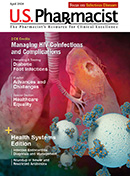BC is associated with an increased annual venous thromboembolic (VTE) risk of 2% to 6% and a twofold elevated risk of atrial fibrillation. Tamoxifen, an estrogen agonist/antagonist used in hormone receptor–positive BC, has a boxed warning about the risk of serious life-threatening and fatal events, including stroke and pulmonary embolism. Additionally, tamoxifen is an inhibitor of CYP3A4 and P-glycoprotein pathways.
DOACs, which include rivaroxaban, apixaban, edoxaban, and dabigatran, are substrates of CYP3A4 and P-glycoprotein cell transporters; edoxaban and dabigatran are involved with the latter pathway; and apixaban and rivaroxaban are involved in both metabolic pathways. Inhibition of one or both pathways can potentially lead to major bleeding or hemorrhage.
Researchers conducted a population-based, retrospective cohort study using data from ICES, an independent, nonprofit research organization that links to multiple population-based health and social databases in Ontario, Canada. These databases included the Ontario Drug Benefit, National Ambulatory Care Reporting System, and the Ontario Cancer Registry.
The study population consisted of persons aged 66 years and old living in Ontario who had filled an outpatient prescription (as determined from the Ontario Drug Benefit) between June 23, 2009, and November 30, 2020, for a DOAC and hormonal therapies, including tamoxifen (the drug of interest) or one of the aromatase inhibitors (AI, i.e., anastrozole, letrozole, or exemestane). Patients had to have had a BC diagnosis in the Ontario Cancer Registry during or within 5 years of concurrent use of a DOAC and tamoxifen or one of the other endocrine agents. A minimum look-back period of 1 year was required.
Study participants were excluded if they had invalid data that could not be linked among the sources; were not residents of Ontario; were aged younger than 66 years at the index data (i.e., the date of concurrent use of a DOAC and tamoxifen or an AI); had a prescription for a non-DOAC anticoagulant; had at least one prescription for a strong CYP3A4 or P-glycoprotein inhibitor (i.e., cyclosporin, tacrolimus, itraconazole, ketoconazole, voriconazole, posaconazole, quinine, and rifampin) within 90 days before the index date; had a concurrent prescription for a CDK4/6 inhibitor (i.e., palbociclib, ribociclib or abemaciclib) with tamoxifen or an AI; was on chronic dialysis or had had a kidney transplant prior to the index date; had index and stop dates on the same day; and had switched tamoxifen or AI therapy within 1 year before the index date.
The primary outcome was a major hemorrhage requiring an emergency department visit. This included gastrointestinal bleeding, intracerebral subarachnoid, or other nontraumatic intracranial hemorrhage. Various definitions of hemorrhage/bleeding were studied. Patients were followed until the primary outcome was met, death, loss of Ontario health insurance eligibility occurred, or until the study ended.
A total of 4,753 patients met study criteria including 4,679 women and 74 men (mean age: 77.4 years). Within this group, one-quarter (24.8%) of patients (n = 1,179) received tamoxifen, and the rest of the 3,574 patients received AIs with 52.2% administered letrozole, 44.2% being given anastrozole, and 3.6% receiving exemestane. Among the DOACs used, 53.2% received rivaroxaban (n = 2,530), 35% received apixaban (n = 1,665), 10.6% received dabigatran (n = 502), and 1.2% received edoxaban (n = 56).
Patients who were administered AIs were younger (71.1 vs. 78.3 years), had a higher Charlson Comorbidity Index (1.8 vs. 1.5), had more advanced disease (stages III and IV in 15.9% and 10.8%, respectively), and were more often women (99.8% vs. 94.2%) versus those who had received tamoxifen, although propensity scoring using overlap weighing was zero. Despite these dissimilarities, the investigators did not find any differences in bleeding between the use of tamoxifen with a DOAC or an AI with a DOAC during a follow-up period of 166 days. The risk of major hemorrhage with concurrent tamoxifen/DOAC was 2.5% versus 3.3% for the AI/DOAC combination. There was also no difference in bleeding (major or all hemorrhage) by DOAC type.
Although this study was a retrospective analysis and cannot establish causality or lack of causality, it offers pharmacists encouraging evidence of the potential safety of tamoxifen/DOAC coadministration.
The content contained in this article is for informational purposes only. The content is not intended to be a substitute for professional advice. Reliance on any information provided in this article is solely at your own risk.
« Click here to return to Breast Cancer Update.






